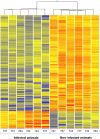Whole Blood Transcriptome Analysis of Mycoplasma mycoides Subsp. mycoides-Infected Cattle Confirms Immunosuppression but Does Not Reflect Local Inflammation
- PMID: 26431338
- PMCID: PMC4592004
- DOI: 10.1371/journal.pone.0139678
Whole Blood Transcriptome Analysis of Mycoplasma mycoides Subsp. mycoides-Infected Cattle Confirms Immunosuppression but Does Not Reflect Local Inflammation
Abstract
Contagious bovine pleuropneumonia (CBPP), caused by Mycoplasma mycoides subsp. mycoides (Mmm), is a severe respiratory disease of cattle responsible for major economic losses in sub-Saharan Africa. Disease control relies mainly on the use of empirically attenuated vaccines that provide limited protection. Thus, understanding the virulence mechanisms used by Mmm as well as the role of the host immune system in disease development, persistence, and control is a prerequisite for the development of new, rationally designed control strategies. The aim of this study was to assess the use of whole blood transcriptome analysis to study cattle-Mmm interactions, starting by the characterization of the bovine response to Mmm infection during the acute form of the disease. For that purpose, we compared the transcriptome profile of whole blood from six cattle, before challenge by contact with Mmm-infected animals and at the appearance of first clinical signs, using a bovine microarray. Functional analysis revealed that 680 annotated genes were differentially expressed, with an overwhelming majority of down-regulated genes characterizing an immunosuppression. The main bio-functions affected were "organismal survival", "cellular development, morphology and functions" and "cell-to cell signaling and interactions". These affected functions were consistent with the results of previous in vitro immunological studies. However, microarray and qPCR validation results did not highlight pro-inflammatory molecules (such as TNFα, TLR2, IL-12B and IL-6), whereas inflammation is one of the most characteristic traits of acute CBPP. This global gene expression pattern may be considered as the result, in blood, of the local pulmonary response and the systemic events occurring during acute CBPP. Nevertheless, to understand the immune events occurring during disease, detailed analyses on the different immune cell subpopulations, either in vivo, at the local site, or in vitro, will be required. Whole blood transcriptome analysis remains an interesting approach for the identification of bio-signatures correlating to recovery and protection, which should facilitate the evaluation and validation of novel vaccine formulations.
Conflict of interest statement
Figures



Similar articles
-
Proteomic characterization of pleural effusion, a specific host niche of Mycoplasma mycoides subsp. mycoides from cattle with contagious bovine pleuropneumonia (CBPP).J Proteomics. 2016 Jan 10;131:93-103. doi: 10.1016/j.jprot.2015.10.016. Epub 2015 Oct 23. J Proteomics. 2016. PMID: 26476145
-
Characterization of the in vitro core surface proteome of Mycoplasma mycoides subsp. mycoides, the causative agent of contagious bovine pleuropneumonia.Vet Microbiol. 2014 Jan 10;168(1):116-23. doi: 10.1016/j.vetmic.2013.10.025. Epub 2013 Nov 11. Vet Microbiol. 2014. PMID: 24332827
-
Evaluation of new generation macrolides for the treatment and metaphylaxis of contagious bovine pleuropneumonia (CBPP) in cattle experimentally infected with Mycoplasma mycoides subspecies mycoides.BMC Vet Res. 2019 Dec 12;15(1):451. doi: 10.1186/s12917-019-2197-x. BMC Vet Res. 2019. PMID: 31831071 Free PMC article.
-
Contagious Bovine Pleuropneumonia: A Comprehensive Overview.Vet Pathol. 2020 Jul;57(4):476-489. doi: 10.1177/0300985820921818. Epub 2020 May 11. Vet Pathol. 2020. PMID: 32390522 Review.
-
Recent Developments in Vaccines for Bovine Mycoplasmoses Caused by Mycoplasma bovis and Mycoplasma mycoides subsp. mycoides.Vaccines (Basel). 2021 May 24;9(6):549. doi: 10.3390/vaccines9060549. Vaccines (Basel). 2021. PMID: 34073966 Free PMC article. Review.
Cited by
-
Pro-Inflammatory Response of Bovine Polymorphonuclear Cells Induced by Mycoplasma mycoides subsp. mycoides.Front Vet Sci. 2020 Mar 27;7:142. doi: 10.3389/fvets.2020.00142. eCollection 2020. Front Vet Sci. 2020. PMID: 32292794 Free PMC article.
-
Comprehensive RNA-Seq Profiling to Evaluate the Sheep Mammary Gland Transcriptome in Response to Experimental Mycoplasma agalactiae Infection.PLoS One. 2017 Jan 12;12(1):e0170015. doi: 10.1371/journal.pone.0170015. eCollection 2017. PLoS One. 2017. PMID: 28081235 Free PMC article.
References
-
- Manso-Silvan L, Vilei EM, Sachse K, Djordjevic SP, Thiaucourt F, Frey J (2009) Mycoplasma leachii sp. nov. as a new species designation for Mycoplasma sp. bovine group 7 of Leach, and reclassification of Mycoplasma mycoides subsp. mycoides LC as a serovar of Mycoplasma mycoides subsp. capri. Int J Syst Evol Microbiol 59: 1353–1358. 10.1099/ijs.0.005546-0 - DOI - PubMed
-
- OIE (2014) Contagious bovine Pleuropneumonia, in: Manual of Diagnostic Tests and Vaccines for Terrestrial Animals. Chapter 2.4.9. http://www.oie.int/fileadmin/Home/eng/Health_standards/tahm/2.04.09_CBPP....
-
- Provost A, Perreau P, Breard A, Le Goff C, Martel JL, Cottew GS (1987) Contagious Bovine Pleuropneumonia. Rev Sci Tech Off Epiz 6: 625–679. - PubMed
-
- Thiaucourt F, Aboubakar Y, Wesonga H, Manso-Silvan L, Blanchard A (2004) Contagious bovine pleuropneumonia vaccines and control strategies: recent data. Dev Biol (Basel) 119: 99–111. - PubMed
Publication types
MeSH terms
LinkOut - more resources
Full Text Sources
Other Literature Sources
Molecular Biology Databases

